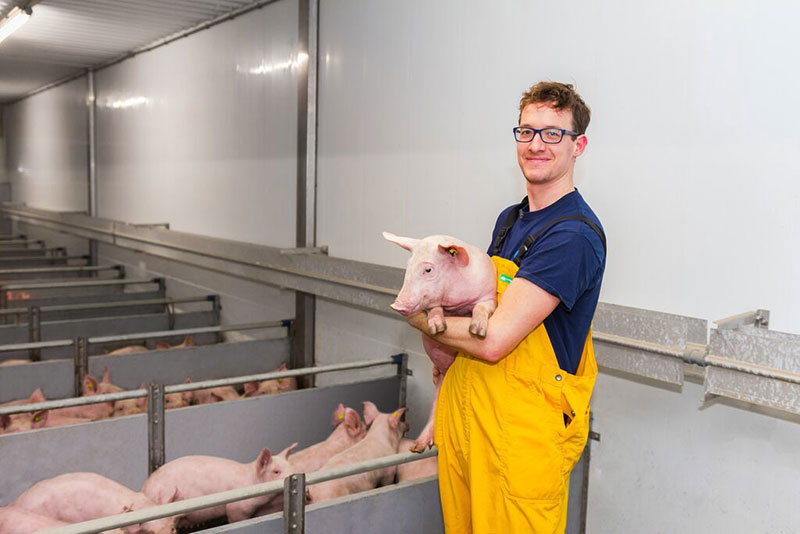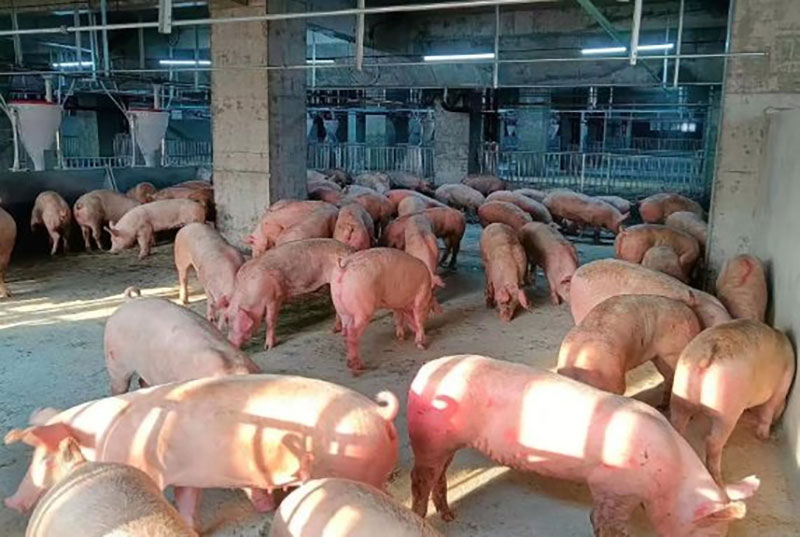The livestock industry worldwide has been experiencing many fluctuations and is forecast to continue to grow in 2024 and the following years. In particular, there are new trends in pig farming.
At the Conference on Promoting Sustainable Pig Farming organized by the Ministry of Agriculture and Rural Development on August 14 in Hanoi, the Department of Livestock Production presented some typical trends in pig farming in the world today that may affect Vietnam’s approach.
Strengthening biosecurity
Given the complicated developments of some dangerous infectious diseases such as acute diarrhea in piglets, porcine reproductive and respiratory syndrome, also known as blue ear disease, or African swine fever, which have caused great damage to the pig farming industry worldwide, the application of biosecurity in farming is extremely urgent for livestock farming in general and pig farming in particular.
 De Heus Group’s bio-secure pig farm. Photo: De Heus
De Heus Group’s bio-secure pig farm. Photo: De Heus
Biosecurity farming has been promoted to change awareness and practice not only applied to pig farms but also applied to all stages of the chain such as input materials, feed, breeds, slaughter, processing, preservation and distribution. Assessing the risk of disease, especially African swine fever, international organizations have issued technical safety guidelines in pig farming. These include the standard “Biosecurity for pig farms, pig slaughterhouses and pig herd restoration” issued by FAO in 2022; “Prevention and biosecurity solutions for small-scale pig farming” and “Biosecurity and disease control chain” issued by the World Organization for Animal Health in 2020; The Philippine Department of Agriculture issued “Technical standards for guidelines for classifying biosecurity pig farms” in 2022; “National Biosecurity Pig Farm Standards” issued by Australia in 2021, etc.
Applying precise technology
Some new, modern technologies have been and are being applied to optimize the ability to develop genetic potential such as self-adjusting the microclimate of the barn (ventilation, temperature, humidity, gas concentration, etc.), precise feeding technology, or using AI to detect abnormalities for diagnosis, limiting human contact and impact, thereby reducing risks and optimizing the system.
Using multi-storey buildings in livestock farming
The solution to raising pigs in high-rise buildings began to appear in 2018 and is mainly applied in China. Up to now, in China, there have been about 1,830 projects with 4,282 high-rise buildings for raising pigs. Typical examples are the Pig Farming Complexes of Yangxiang Company; Hubei Zhongxin Kaiwei Modern Animal Husbandry’s pig farming complex, etc. Notably, in late September 2023, the first sows were brought to the giant 26-story building in central China. This is where they live from infancy to adulthood. Every day, more than 453,000kg of feed is delivered to the floors, while the pigs’ feces are also weighed, aggregated and reused.
 Pigs are raised in a 29-story building in China. Photo: ST
Pigs are raised in a 29-story building in China. Photo: ST
Applying organic farming
This trend mainly serves the market segment for people with economic conditions and awareness of organic and environmentally friendly products.
Reducing emissions, raising livestock according to the circular economic model
This method both solves the challenge of greenhouse gas emissions and is an opportunity to increase added value for livestock farming, when livestock waste is a renewable source of raw materials after being treated with technology and techniques for other production activities.
Antibiotic-free and zinc oxide (ZnO)-free
High-dose zinc oxide is an effective weapon against gastrointestinal bacteria that commonly cause diarrhea during the weaning period in piglets. However, starting in June 2022, the EU has implemented a ban on the use of ZnO in weaning pig diets. This decision has started a fierce race to find an alternative. This shows that there is a growing global awareness of more caution in the use of antibiotics.
Humane treatment of animals
For farmers in all countries, humane treatment of animals means providing pain relief during unavoidable confrontation procedures; Ensuring that all animals are provided with appropriate nutrition, especially when pregnant; Keeping animals calm with low-stress handling; Treating animals with respect at slaughter in a way that they are not subjected to unnecessary pain or suffering; Pursuing non-invasive alternatives to surgical procedures. In pig farming, humane treatment will be demonstrated by housing (size and construction), farmer knowledge, and pressure from and consumers.
Humane treatment of animals
For farmers in all countries, humane treatment of animals means providing pain relief during unavoidable confrontation procedures; Ensuring that all animals are provided with appropriate nutrition, especially when pregnant; Keeping animals calm with low-stress handling; Treating animals with respect at slaughter in a way that they are not subjected to unnecessary pain or suffering; Pursuing non-invasive alternatives to surgical procedures. In pig farming, humane treatment will be demonstrated by housing (size and construction), farmer knowledge, and pressure from and consumers.
Digital transformation and social media
Increasingly used in many smart farms to monitor, manage livestock, trace the origin from farm to table. Information technology also contributes to updating statistics, analyzing and forecasting the market. Communication, public information transparency is an important commitment of producers to the community.
Thuy Khanh
